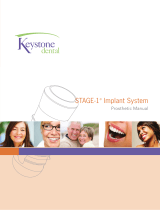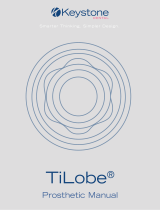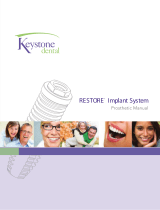Page is loading ...

Training manual - DS10
Training manual

Renishaw part no: H-5489-8780-01-A
First issued: February 2017
© 2017 Renishaw plc. All rights reserved.
This document may not be copied or reproduced in whole or in part, or transferred to any other media
or language, by any means, without the prior written permission of Renishaw plc.
The publication of material within this document does not imply freedom from the patent rights of
Renishaw plc.
Disclaimer
RENISHAW HAS MADE CONSIDERABLE EFFORTS TO ENSURE THAT THE CONTENT OF
THIS DOCUMENT IS CORRECT AT THE DATE OF PUBLICATION. RENISHAW MAY UPDATE
THIS DOCUMENT FROM TIME TO TIME, SO USERS ARE ADVISED TO ENSURE THEY
HAVE THE LATEST VERSION BY VISITING THE DENTAL SECTION OF THE WEBSITE AT
WWW.RENISHAW.COM. TO THE MAXIMUM EXTENT PERMISSIBLE AT LAW, RENISHAW
EXCLUDES LIABILITY, HOWSOEVER ARISING, FOR ANY INACCURACIES IN THIS DOCUMENT.
Trade marks
RENISHAW and the probe symbol used in the RENISHAW logo are registered trade marks of
Renishaw plc in the UK and other countries. apply innovation, DS10 and names and designations of
other Renishaw products and technologies are trade marks of Renishaw plc or its subsidiaries.
All other brand names and product names used in this document are trade names, trade marks, or
registered trade marks of their respective owners.

i
Contents
Installation and set-up ...............................................1
Hardware installation ...........................................................1
Unpacking the machine ......................................................1
Inside the box ..............................................................2
Loading the probe module ....................................................2
Renishaw DS10 connections ..................................................3
Machine maintenance ................................................4
Cleaning ....................................................................4
Cleaning the scanner ........................................................4
Cleaning the probe body, probe module and stylus .................................4
Cleaning the accessories .....................................................5
System Specification ................................................6
Renishaw DS10 ...............................................................6
Minimum PC specification .......................................................7
Parts lists ..........................................................8
Main parts list ................................................................8
Contents

1
Hardware installation
Unpacking the machine
2. Remove the 4 × retaining clips.
3. Remove the outer cover and place the machine on a solid
work surface.
1. Remove the outer box and follow the instructions printed on the box inside.
2
3
4. Undo the strap that holds the mechanism packaging.
5. Remove the transit packaging by unhooking it from the
probe body.
4
5
6. Lift the DS10 scanner from the packaging and place on a
solid work surface.
Installation and set-up

2
Installation and
set-up
DS10 training manual
2. Remove the end cap from the probe body.
1. Remove the probe module from the
accessory case and remove
the protective end
caps.
Inside the box
•
1 × Renishaw DS10 scanner
• 1 × power supply (specific to region)
• 1 × USB cable
• 1 × accessories kit
Accessories kit
Jaw holder
platform
Jaw holder
3 mm Ø stylus
(stylus B)
Die holder jaw
retainer
Artefact base
adaptor
Calibration ball
Kinematic jaw
plate
Empty slot
Gimbal
1 mm Ø stylus
(stylus A)
10 mm spacer
Die holder
SM25–1 probe
module
Loading the probe module
The probe module needs to be connected to the probe body to enable the measuring system to
operate.
CAUTION: Do not touch the glass window as it can impair the accuracy of the scanned data.
!
To view a list of all available parts, see the ' Parts List' section at the rear of this document

3
Installation and
set-up
4. Slightly tilt the module with the lower alignment dot
facing towards you, offer it up and 'roll' it into position,
allowing the magnetic force to gently connect the
kinematic joint.
Renishaw DS10 connections
Not used Not used
USB connection
to the PC
Power connection
3. There is a magnetic location system that retains the module in position. Align the front of the
probe module (indicated by the dot marker above the word 'Renishaw') with the front of the probe
body.

4
The Renishaw DS10 scanner is a precision instrument and must be handled accordingly.
Cleaning
WARNING: Disconnect the power before cleaning the scanner.
Cleaning the scanner
The components of the scanner do not require any special maintenance other than cleaning. A lint-free
cloth and glass cleaner can be used to clean all outer surfaces of the scanner body. Avoid cleaning
the internal components and mechanics of the scanner. If these areas do need cleaning, an air-blast
should be used. Cleaning solutions are not recommended.
Cleaning the probe body, probe module and stylus
The probe assemblies are fitted with kinematic coupling mechanisms. These utilise precision ball and
V-groove seatings, electrical contacts and permanent magnets.
It is recommended that these features are cleaned at the following intervals:
• Before the scanner is used for the first time.
• After every 500 changes.
Removing the probe module and stylus
You must remove the probe module and stylus from the probe body before cleaning the probe. The
probe body forms part of the mechanism of the scanner and cannot be removed.
Remove the stylus by holding the stem and tilting it away, breaking the magnetic joint. Remove the
probe module by holding it and tilting it away from the probe body.
!
Machine maintenance

5
Machine
maintenance
DS10 training manual
Cleaning the probe body and module
A cleaning kit is supplied for cleaning the kinematic coupling mechanisms of the probe assembly. This
comprises 'yellow tack' strips and an optical cleaning cloth.
IMPORTANT: Do not use the yellow tack to clean the optical window of the probe body or module.
1. Clean the external surfaces only using a lint-free cloth. All parts must be kept dry.
2. With clean hands, take off a small piece of yellow tack and shape it into a ball. Press it onto and
into each feature.
3. Using the optical cleaning cloth, clean the optical windows on the underside of the probe body
and topside of the probe module.
Cleaning the stylus mount and stylus
Regularly inspect the ball of each stylus for damage or component material deposits.
1. Clean the stylus ball and mating face using the cleaning cloth or a solvent.
Refitting the probe module and stylus
1. Align the front of the probe module (indicated by the dot marker above the word 'Renishaw') with
the front of the probe body.
2. Slightly tilt the module with the lower alignment dot facing towards you, offer it up and 'roll' it into
position, allowing the magnetic force to gently connect the kinematic joint.
3. Align the stylus with the probe module by pairing the white line with dot marker.
4. Tilt the probe so the stem is facing towards you, offer it up to the module and roll it into position,
allowing the magnetic force to gently connect the kinematic joint.
Cleaning the accessories
1. Dampen a cloth with glass cleaner and clean each of the accessories.
2. Use a soft brush if any of the clamping faces need cleaning.
!

6
Dimensions
Width
Depth
Height
300 mm (11.8 in)
400 mm (15.7 in)
550 mm (21.7 in)
Weight
25 kg (maximum)
Operating environment
Temperature
Relative humidity
Altitude
15 °C to 26 °C (maximum temperature
change of 2 °C per hour)
20% to 80%
2000 m maximum
Transportation environment
Temperature
Humidity
20 °C to +70 °C
0% to 95%
Voltage for power supply
(ac to dc adaptor)
100 V to 240 V ac
Frequency range
50 Hz to 60 Hz
Voltage for scanner
18 V dc
Power supply rating
70 W
Communications to PC
USB
Connectors on scanner
USB, power
Switch
On / off power
Renishaw DS10
System Specification

7
System
specification
DS10 training manual
Minimum PC specification
Note: A dual-core processor is recommended if operating the scanner and milling machine from the
same PC.
Processor
Intel Pentium 4, 3.0 GHz (or equivalent)
Hard drive
100 MB minimum free space is required for installation.
Additional hard disk space is required to store frameworks as they
are created. A minimum of 200 GB is recommended.
Memory
1 GB RAM (for Windows XP SP3)
2 GB RAM (for Windows Vista SP1 and Windows 7)
Graphics adaptor
Fully DirectX 9 compatible graphics adaptor
256 MB (minimum) video RAM
Colour display resolution
1024 × 768 capable
Mouse
Scroll-wheel or 2-button mouse or pointing device
CD-ROM drive
Required for software installation
USB
Three USB ports are required
Broadband internet
connection
Minimum 2 Mb/s, operational
PC operating system
Microsoft Windows XP SP3 (x32 Edition only)
Windows Vista (x32 and x64)
Windows 7 (x32 and x64)

8
Part Part number Description
A-5351-0060 Probe body and module cleaning kit
A-2237-1111 Probe module (SM25-1)
A-5351-4150 Packaging kit
A-5351-4151 Gimbal
A-5351-4152 Jaw holder
A-5351-4153 Die holder
A-5351-4154 Artefact base adaptor
A-5351-4155 10 mm spacer
A-5351-4156 Jaw holder platform
A-5351-4157 Calibration ball
A-5351-0095 Link abutment holder kit
A-5495-0060 Implant bridge holder kit
A-5351-1003 Wax abutment holder kit
A-5351-4159 1 mm stylus (Stylus A)
A-5351-4260 3 mm stylus (Stylus B)
A-5351-4233 T-stylus (Stylus C)
A-5351-4270 Die holder jaw retainer
A-5351-4271 Kinematic jaw plate kit
P-EA02-0020 Power supply unit
P-CA38-0006 Power cable (UK)
P-CA38-0036 Power cable (US)
M-5351-1025 Dust cover
Main parts list
Parts lists

Renishaw plc
New Mills, Wotton-under-Edge,
Gloucestershire, GL12 8JR
United Kingdom
T +44 (0)1453 524524
F +44 (0)1453 524901
E uk@renishaw.com
www.renishaw.com
For worldwide contact details,
please visit our main website at:
www.renishaw.com
*H-5489-8780-01
© 2017 Renishaw plc Issued February 2017 Part no. H-5489-8780-01-A
/



